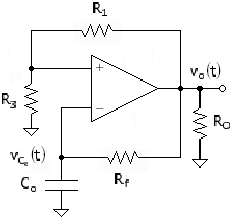12.2. Operational Amplifier Oscillator
The opamp can serve as a square-wave oscillator by adding positive feedback with R1 and R3 and replacing Ry with a capacitor Co, as shown in Fig. 12.2. The frequency of the operation can be computed on the basis of the following derivation. With positive feedback, the circuit is unstable and the output voltage is either Vop or –Vom, that is, the positive or negative limit. The limits are close to VDD or VSS. These voltage values are applied to the input through the positive feedback network such that the plus input terminal is either at
Equation 12.11
![]()
or
Equation 12.12
![]()
Figure 12.2. Opamp oscillator. The frequency is determined by the value of resistors and the capacitor.

where Vom is positive.
However, the negative-feedback circuit consisting of Rf and Co will cause the capacitor to charge up toward the voltage at the output. For example, suppose that for an interval of time, vo(t) = Vop ≈ VDD. Also assume that R3 = R1 such that the plus input is at Vop/2. When the capacitor charges up to and just beyond Vop/2, the opamp input V∊ changes sign and the output will switch over to vo(t) = –Vom. At this point, the capacitor begins charging toward the opposite polarity, and so forth.
For a given output, the time-dependent capacitor voltage is a simple RC transient. For example, for vo(t) = Vop,
Equation 12.13

with a steady-state value of Vop. As an oscillator, the capacitor voltage will never reach the steady-state value; the transient terminates at the value given by (12.11).
The output is switching back and forth from Vop to –Vom. Therefore, the initial value of the capacitor voltage in (12.13) is
Equation 12.14
![]()
Using this to obtain a complete solution for (12.13) results in
Equation 12.15

We define t = Tplus as the positive time segment of the square-wave period. As noted, this corresponds to the time where the output switches to –Vom; that is,
Equation 12.16
![]()
Using (12.16) in the left-hand side of (12.15) gives an equation for Tplus as follows:
Equation 12.17

Then, solving for Tplus results in
Equation 12.18

Following the reasoning that led to (12.15), the falling capacitor-voltage transient is
Equation 12.19

The total time interval (negative segment of the square-wave period) of the falling transient, t = Tminus, corresponds to the capacitor voltage, decreasing to
Equation 12.20
![]()
Using (12.20) in (12.19) gives the equation for Tminus, which is
Equation 12.21

This leads to
Equation 12.22

A special case is for R1 = R3, where (12.18) and (12.22) become
Equation 12.23
![]()
and
Equation 12.24
![]()
The oscillator period is T = Tplus + Tminus or, for this special case,
Equation 12.25
![]()
A good estimate comes from the approximation Vop ≈ Vom. The result is
Equation 12.26
![]()
Note that although Tminus and Tplus can be significantly different [from (12.18) and (12.22)], the sum is well represented by (12.26). Note also that the waveform is strictly a square-wave only if Vop = Vom.
LabVIEW uses (12.25) to calculate the actual value of the capacitor used in the project on the oscillator. In the project, period T is a measured value. Shown in Fig. 12.3 is a project result of the measurement of the output voltage and capacitor voltage for the oscillator. Power-supply voltages were set at plus and minus eight volts and R1 = R3.
Figure 12.3. Oscillator vo(t) and vco(t) versus t (ms). Note that the switching takes place where the capacitor voltage reaches about one-half of the square-wave peak magnitude. This is for R1 = R3.

